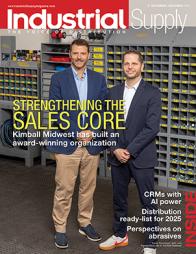Your customers have choices
It's time to update your old customer satisfaction surveys
by Frank Hurtte
My parents contended with two types of ice cream, vanilla or chocolate. Their television received three channels. There was one phone company, one neighborhood grocery and, at least in my home town, one stoplight. Choices were limited and change slow.
Fast forward to today when 31 flavors gets trumped by a place in Venezuela with 860 types of ice cream. Cable, Direct and Dish pitch their seemingly limitless number of channels in high definition. Scientifically selecting a simple cell phone requires weeks of research and an intricate spreadsheet. We’ve got choices, a Niagara Falls of choices. There are more and more options in our personal life – and our customers experience exactly the same thing. The alternatives available are growing, doubling, figuratively exploding.
Not all that long ago, experts encouraged distributors to periodically survey their customers to develop metrics around service quality and customer satisfaction with a dash of competitive positioning thrown in to share with suppliers. At the time, that was probably a good idea, but in light of today’s choice driven environment, the whole thing seems a bit static and rear sighted.
With this ever expanding set of alternatives, wouldn’t it be nice to understand precisely why your customers have selected you? Simply stated, why do they buy from you, as opposed to the dozens of other possibilities? This adds a whole new dimension to the survey puzzle.
Why do you select us?
Distributors are being pulled in a hundred directions. For instance, techno-issues get a lot of press these days. Here’s the abbreviated menu of subtopics: online catalogs, websites, Search Engine Optimization (SEO), mobile apps for customers and technology-enabled vending machines. But if your customers have selected you because of your ability to solve ground-zero technical issues, investments in online catalogs may carry dubious return. At the same time, if customers select you based on a perception of ease of doing business, these new technologies might be part of your future. The question is how to tell.
A survey with properly focused questions allows customers to deliver feedback on their reason for selecting you. For example, survey questions might look like this:
We would like to better understand how ourproducts and services are used in your facility. Please share your insight so that we can better understand how to serve you.
This Distributor’s products are used (select all that apply):
- In mission-critical applications where downtime is costly
- As an integral part of our product
- In routine maintenance operations
- In backups to existing products already identified
- In the maintenance room crib stock
- In instances where price/performance are important
Follow-up questions drill into how the customer relies on your organization for technical support, training, subassemblies, kitting and services. To help prime the pump, here is an example built around technical expertise.
The technical expertise associated with the products provided by This Distributor can be described using the following (check all that apply):
- Easy to understand and nearly everyone knows how to apply them
- Some applications require hands-on guidance
- Use can be tricky and assistance is required regularly
- If additional expertise were available, we would likely use it
Surveys are just a starting point in the process of understanding why customers buy from you. Even using the advanced features of electronic survey tools (SurveyMonkey,
Zoomerang and others), gathering an unbiased story can be difficult. Purchasing agents play up the importance of price. Friends tell you what they hope you want to hear. And, different customer contacts buy for an assortment of reasons all tied to their own job responsibilities. Direct customer contact allows for your organization to pull even more useful data.
Despite their ongoing rapport with customers, salespeople typically do poorly in their efforts to gather critical data. Rightly or no, sellers hesitate to ask the right questions because they believe the customer expects them to already know the answer. To get around this, many companies make use of either a member of the management team, somebody like the sales manager, inside sales manager, marketing manager or CFO, to conduct interviews.
One industrially focused electrical distributor has devised what it calls “Concierge Service.” In this program, a Sales Concierge visits top customers once a year to ask questions about why the customer buys and how service might be better matched to customer needs. Interestingly, the “concierge” has managed to bring back scores of new customer contacts and ideas for expanding sales to top customers, many times spotting points missed during routine sales visits.
Understanding competitive positioning
Using survey methodology to gauge your competitive positioning is another valuable tool for developing your business. Unlike gathering information from existing customers, talking to competitive customers can be tricky and mean. Unlike your existing customers, this group is most likely not inclined to directly provide you with beneficial information.
Gathering this data requires the use of a third party, but this need not be an expensive ordeal. Many distributors have made use of the resources of a local college or university to gather the information. Equal parts graduate level research project and paid internship, college students reach out to a prescribed group of customers (typically generated from manufacturers directly) to determine relative competitive rankings based on products and services. It’s a win-win for everyone. The distributor provides much needed guidance around questions and contacts. The university (student, staff or otherwise) develops real-world experience. Because the person conducting the survey identifies with the college
or university, customers are more likely to answer candid questions without bias.
We like questions that call out names. For instance, “Which two local companies provide the best technical support for industrial widgets?” Or another one might be, “Which companies are your favorite choices for widget supply? Why?”
Once tabulated, it falls to you to draw conclusions from the data. Most distributors recognize the strengths and weaknesses of their competitors (often better than they know their own). Matching pairs of companies provides an interesting point of view. Customers rarely cite price-driven and knowledge-based suppliers as their paired favorite.
Distributor R&D
Let’s think about research and development. Top companies invest a percentage of their revenue to develop the product offering of the future. Often, they focus on new technology, market demographics and major breakthroughs likely to change their world. Now think for a moment. Would you invest in a company with no research and development?
Distributors let themselves off the hook by proclaiming, “We don’t make a product, so we don’t need R&D.” I disagree. We are our product. The package of value we provide consists of our bundle of products, logistics, customer-based and product enhancing services and our ability to provide consultative advice along the way. Matching these to future customer needs determines our future relationship with the customer. I recommend an R&D meeting with your top customers. Allow me to choreograph the meeting.
First, R&D meetings require someone from the customer who really understands the direction. That maintenance supervisor your salesperson spends lots of time with probably is a nice guy. He may have a number of valuable thoughts about the customer’s operation. He might be able to steer you to new business. But understand this, unless the company is very small, he has no clear picture of the long-term issues of the customer. To achieve this, you need somebody higher in the organization, as high as you can arrange a meeting with.
Secondly, R&D meetings are not sales meetings. Any mention of products, services or combination of the two is strictly taboo. The meetings are best held at the management level. Ignorance of the current situation is often a strategic advantage.
The meetings are set up with the following thought: “We appreciate the business you are doing with us. Our team is working to make certain we provide you with the services important to your current operations. We want to make certain we have the right stuff to serve you in the future, five years from now. We need to know your plans in order
to develop our plans. Can you give me your vision of the future?” Then sit back, listen and take notes. No selling allowed.
A parting thought
Earlier this year, David Bauders of Strategic Pricing Associates asked a group of leaders from the distribution industry a couple of thought-provoking questions. Allow me to pass them along to you.
- What are you doing to make it better to be your customer this year than last year?
- Why will it be harder for a competitor to take your spot at the customer in 2013 than in 2012?
The answers to these questions are just guesses if you haven’t taken the time to gather data.
 Frank Hurtte speaks, writes and consults with distributors on methods for adding bucks to their bottom line. Frank is available at frank@riverheightsconsulting.com or via phone at (563) 514-1104.
Frank Hurtte speaks, writes and consults with distributors on methods for adding bucks to their bottom line. Frank is available at frank@riverheightsconsulting.com or via phone at (563) 514-1104.
This article originally appeared in the May/June 2013 issue of Industrial Supply magazine. Copyright 2013, Direct Business Media.













